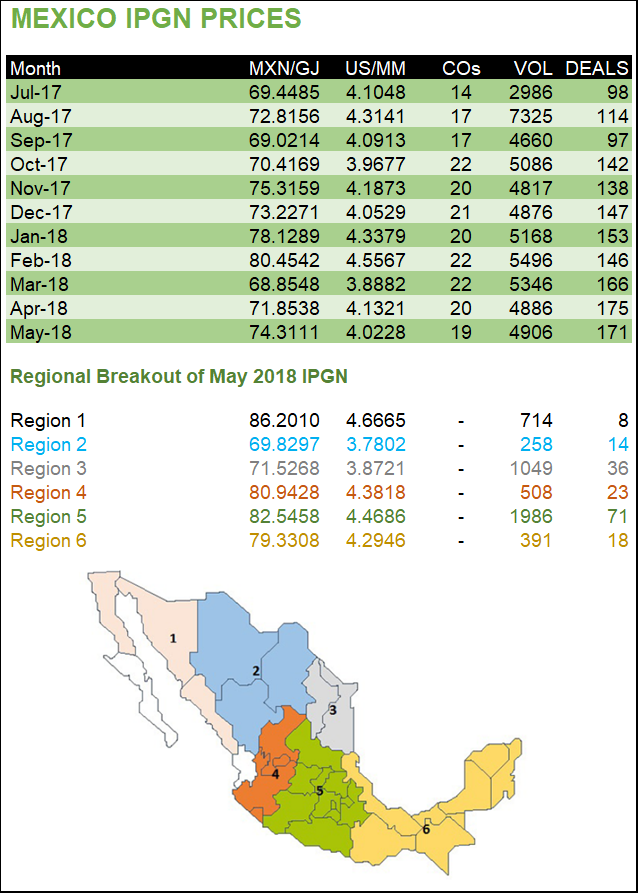Markets | NGI All News Access | NGI The Weekly Gas Market Report
Mexico Natural Gas Prices Continue to Rise in May, but Currency Effects Limit Gains in Dollars
Natural gas prices in Mexico continued to rise in May, building on gains from the previous month, according to energy regulators.

The national average price of gas in May increased by 2.457 pesos to 74.311 pesos/gigajoule (GJ), or $4.023/MMbtu, the Comision Reguladora de Energia (CRE) reported this week. Prices also rose in all but one of CRE’s six trading regions, ranging from a 2.190-peso uptick in Region 3 to a 4.081-peso rise in Region 4.
In U.S. dollars, however, gas prices were down throughout Mexico due to a weaker peso in May, compared to the April MXN-USD exchange rate.

The CRE started releasing its gas price index, known as the IPGN, in August last year. The regulator began publishing regional prices in March.
The indexes, which show the price per molecule plus transport costs, are derived from the monthly post-transaction reports that are mandatory for all gas marketers billing trades within Mexico.
In May, 19 natural gas marketers reported 179 transactions to the regulator. The CRE screened out eight statistically atypical deals before calculating the final indexes.
The total trading volume for the deals reported in May was 4.91 Bcf/d, up slightly from 4.89 Bcf/d in April. Mexican demand is closer to 8 Bcf/d, but the CRE indexes do not capture gas used in upstream activities by state oil company Petroleos Mexicanos (Pemex) and other oil and gas operators.
Of the six trading zones, central-northern Region 2 was the only one to report a decrease in pesos during May. The region also had the lowest price and volume of the month. Marketers in Region 2 transacted 258 MMcf/d at an average price of 69.830 pesos/GJ ($3.780/MMbtu), down 4.471 pesos compared to April.
Region 2 is home to several private pipelines that would carry U.S. gas exports from the Waha hub in the Permian Basin to Mexican consumers in the northwest and farther south along the Pacific Coast, as well as central Mexico. Delays to downstream projects on the Mexican side of the border have constrained shipments into this region, although the remaining pipelines are expected to come in-service later this year.
The northwest Region 1 reported the highest price of May at 86.201 pesos/GJ ($4.667/MMbtu), up 3.130 pesos from April. Marketers reported volumes of 714 MMcf/d for the region, which includes two isolated pipeline systems and a new network of private pipelines extending south from the Arizona border to the city of Mazatlan in Sinaloa.
More than 60% of May’s trading occurred in just two areas: Region 3 in the northeast and Region 5 in central Mexico.
Region 5 contains some of the country’s most densely populated areas, including Mexico City. Marketers in the region transacted 1.99 Bcf/d at an average price of 82.546 pesos/GJ ($4.469/MMbtu), up 2.310 pesos from April.
Much of the gas consumed in Region 5 is shipped through Region 3, which is home to NET Mexico and several other cross-border pipelines connected to South Texas gas transmission networks. Region 3 also contains the industrialized states of Nuevo Leon and Tamaulipas.
Prices in Region 3 averaged 71.527 pesos/GJ ($3.872/MMbtu) in May, up 2.190 pesos from April. Marketers in the region transacted 1.05 Bcf/d.
Prices in Region 4, which covers parts of central Mexico and the southwest coast, averaged 80.943 pesos/GJ ($4.382/MMbtu ) in May, up 4.081 pesos from April. Marketers billed deals for a total volume of 508 MMcf/d during the month.
Region 4 contains the Pacific Coast state of Colima, which includes the Manzanillo liquefied natural gas (LNG) terminal. Another LNG import facility, the Altamira terminal, sits on the Gulf Coast near the boundary between regions 3 and 5. A third LNG terminal on the Baja California Peninsula, in Region 1, has not supplied gas to Mexican consumers since around mid-2016.
The southeast Region 6 reported an average price of 79.331 pesos/GJ ($4.295/MMbtu) in May, up 2.443 pesos from April, and a trading volume of 391 MMcf/d. The region includes the Yucatan Peninsula, which experienced rolling blackouts on several days in May and early July due to hot weather, strong demand and limited gas supply.
Mexico authorities recently announced two infrastructure projects, worth a combined $85 million, that would shore up gas supply in the Yucatan region.
The CRE’s price indexes are intended to be indicative and temporary, to be replaced by third-party indexes once the market is able to develop them on its own. Most trades in the Mexican gas market are currently priced with U.S. indexes like Henry Hub and Houston Ship Channel, plus transport costs.
© 2024 Natural Gas Intelligence. All rights reserved.
ISSN © 2577-9877 | ISSN © 2577-9966 | ISSN © 1532-1266 |
